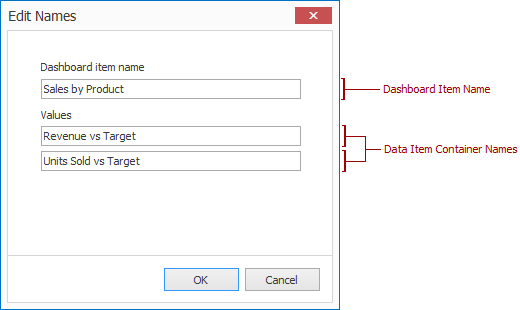Dashboard Item Caption in the WinForms Designer
- 9 minutes to read
Each dashboard item has a caption that is displayed at the top of this item. The caption contains static text and command buttons.
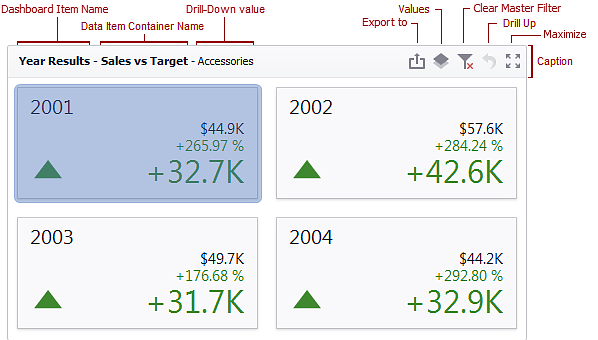
Click the Show Caption button in the Design Ribbon tab to show or hide the caption of a dashboard item:
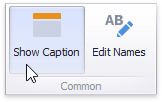
The second method is to right-click the item and select Show Caption in the invoked pop-up menu:
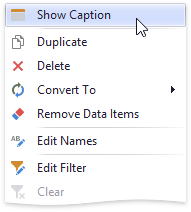
Use the DashboardItem.ShowCaption property to specify whether the caption of the dashboard item is displayed.
Note
The caption of the Range Filter dashboard item is not visible unless explicitly specified.
The caption of the dashboard item contains the following information and buttons, depending on the dashboard item type.
Names |
You can change the name using the Edit Names dialog. To invoke this dialog, right-click the item when designing the dashboard, and click the Edit Names… menu item or click the Edit Names button in the Design Ribbon tab.
Tip The string supplied as the Dashboard Item Name can contain HTML Tags. For example, the following string displays bold text: “<b>Caption</b>“. Note that img tags are not supported. To insert images in the dashboard item caption use the run-time customization approach.
|
Interactivity Information |
|
Command Buttons |
|
Runtime Customization
You can also customize the dashboard item caption in your application at runtime if you handle the DashboardDesigner.CustomizeDashboardItemCaption event. This method allows you to modify the text displayed in the title, remove existing buttons, and add custom buttons and drop-down menus to execute actions that can benefit users.
The following properties are accessible in the CustomizeDashboardItemCaption event handler:
The text displayed in the dashboard item caption. | ||
Additional text displayed in the caption to the left of the main text. You can provide any relevant text. | ||
Provides access to a collection of items (command buttons and other bar items) located in the dashboard item caption. You can modify the collection to remove or add built-in or custom items. | ||
Provides you with the DashboardItem.ComponentName property value. You can use it to identify a dashboard item for which the event occurs. | ||
Allows you to hide the caption of a certain dashboard item. |
Example
This example demonstrates how to handle the IDashboardControl.CustomizeDashboardItemCaption and IDashboardControl.CustomizeDashboardTitle events to modify dashboard title and dashboard item captions.
The dashboard title displays the dimensions and values by which the dashboard data is filtered. You can use a drop-down menu to selectively hide dashboard item captions. Clicking a custom Support button navigates to this example online.
A dashboard item caption displays the item’s master filter values.
Export buttons are hidden for all dashboard items except the map, and for the entire dashboard, if the displayed data’s Category field contains “Bikes”.
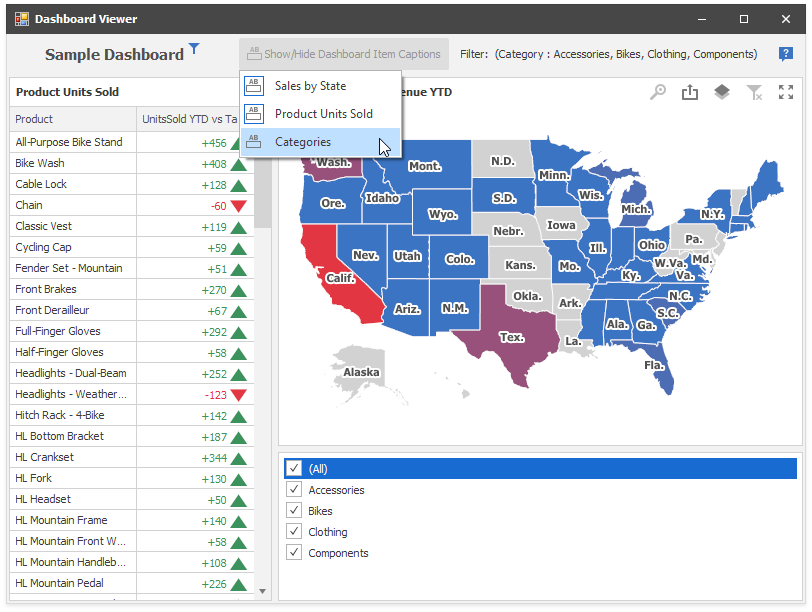
using DevExpress.DashboardCommon;
using DevExpress.DashboardCommon.ViewerData;
using DevExpress.DashboardWin;
using System;
using System.Collections.Generic;
using System.Data;
using System.Linq;
namespace CustomizeDashboardItemCaption_Viewer_Example {
public partial class ViewerForm1 : DevExpress.XtraEditors.XtraForm {
private static bool allowExport = false;
public ViewerForm1() {
InitializeComponent();
dashboardViewer.AllowPrintDashboardItems = true;
dashboardViewer.CustomizeDashboardTitle += DashboardViewer_CustomizeDashboardTitle;
dashboardViewer.CustomizeDashboardItemCaption += DashboardViewer_CustomizeDashboardItemCaption;
dashboardViewer.PopupMenuShowing += DashboardViewer_PopupMenuShowing;
dashboardViewer.MasterFilterSet += DashboardViewer_MasterFilterSet;
dashboardViewer.UpdateDashboardTitle();
UpdateDashboardItemCaptions();
}
private void DashboardViewer_CustomizeDashboardTitle(object sender, CustomizeDashboardTitleEventArgs e) {
DashboardViewer viewer = (DashboardViewer)sender;
// Display a string of master filter values.
string filterText = string.Empty;
foreach (var item in viewer.Dashboard.Items) {
if (viewer.CanSetMasterFilter(item.ComponentName)) {
var filterValues = viewer.GetCurrentFilterValues(item.ComponentName);
filterText += GetFilterText(filterValues);
}
}
DashboardToolbarItem toolbarItem = new DashboardToolbarItem();
toolbarItem.Caption = "Filter: " + filterText;
e.Items.Insert(0, toolbarItem);
// Remove the Export button depending on the static variable.
if (!allowExport) {
RemoveExportButton(e.Items);
}
// Add drop-down menu to show/hide dashboard item captions.
DashboardToolbarItem toolbarItemRoot = new DashboardToolbarItem();
toolbarItemRoot.Caption = @"Show/Hide Dashboard Item Captions";
toolbarItemRoot.SvgImage = svgImageCollection1["title"];
foreach (var item in viewer.Dashboard.Items) {
DashboardToolbarMenuItem menuItem = new DashboardToolbarMenuItem(item.ShowCaption, item.Name,
new Action<DashboardToolbarItemClickEventArgs>((args) => {
item.ShowCaption = !item.ShowCaption;
}));
menuItem.ImageOptions.SvgImage = svgImageCollection1["title"];
toolbarItemRoot.MenuItems.Add(menuItem);
}
e.Items.Insert(0, toolbarItemRoot);
// Add a button with an image to navigate to Online Help.
DashboardToolbarItem infoLinkItem = new DashboardToolbarItem("",
new Action<DashboardToolbarItemClickEventArgs>((args) => {
System.Diagnostics.Process.Start("https://docs.devexpress.com/Dashboard/");
}));
// Note that a raster image is proportionally resized to 24 px height when displayed in the Title area.
infoLinkItem.SvgImage = svgImageCollection1["support"];
e.Items.Add(infoLinkItem);
}
private void DashboardViewer_CustomizeDashboardItemCaption(object sender, CustomizeDashboardItemCaptionEventArgs e) {
// Remove the Export button depending on the static variable.
if (!allowExport) {
if (!e.DashboardItemName.Contains("Map")) {
RemoveExportButton(e.Items);
}
}
// Display filter values.
DashboardViewer viewer = (DashboardViewer)sender;
var filterValues = viewer.GetCurrentFilterValues(e.DashboardItemName);
if (filterValues != null)
if (filterValues.Count > 0)
e.FilterText = string.Format(" ( Filter: {0})", string.Concat(filterValues.Select(
axp => string.Format("{0} ", axp.GetAxisPoint(axp.AvailableAxisNames[0]).DisplayText)).ToArray()));
}
private void DashboardViewer_PopupMenuShowing(object sender, DashboardPopupMenuShowingEventArgs e) {
// Hide popup menu everywhere except the dashboard title, to hide commands related to the export actions.
if (e.DashboardArea == DashboardArea.DashboardItem)
e.Allow = false;
}
private void DashboardViewer_MasterFilterSet(object sender, MasterFilterSetEventArgs e) {
if (e.DashboardItemName == "listBoxDashboardItem1")
allowExport = e.SelectedValues.Select(value => value[0].ToString()).Contains("Bikes") ? false : true;
UpdateDashboardItemCaptions();
dashboardViewer.UpdateDashboardTitle();
}
private string GetFilterText(IList<AxisPointTuple> filterValues) {
string filterText = string.Empty;
if (filterValues.Count > 0) {
string dimensionName = string.Concat(filterValues.Select(
axp => string.Format("{0} ", axp.GetAxisPoint(axp.AvailableAxisNames[0]).Dimension.Name)).Distinct());
filterText = string.Format(" ({0}:{1})", dimensionName, string.Join(",", filterValues.Select(
axp => string.Format(" {0}", axp.GetAxisPoint(axp.AvailableAxisNames[0]).DisplayText)).ToArray()));
}
return filterText;
}
private void UpdateDashboardItemCaptions() {
foreach (DashboardItem i in dashboardViewer.Dashboard.Items) {
dashboardViewer.UpdateDashboardItemCaption(i.ComponentName);
}
}
private void RemoveExportButton(IList<DashboardToolbarItem> items) {
var exportItem = items.FirstOrDefault(i => i.ButtonType == DashboardButtonType.Export);
if (exportItem != null) {
items.Remove(exportItem);
}
}
}
}
